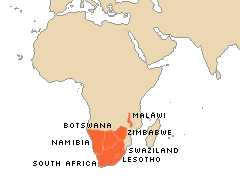
How do we know
Data on case incidence and deaths were reported through the strengthened surveillance system in the region and hospital registers. Hospital records were analyzed to compare the number of children admitted with measles before and after the catch-up campaigns.Downloads
- Read the entire case study
(PDF | 113 kb)
Health Condition: Measles, one of the most contagious infections known to humans, ranks among the top four childhood killers worldwide. Despite the existence of a safe and effective vaccine, an estimated 30 to 40 million cases of the disease and some 454,000 deaths occurred in 2004. Just under half of these deaths were in sub-Saharan Africa, where measles kills more children than HIV/AIDS. In 1996, the seven countries of southern Africa reported a total of 60,000 measles cases and 166 measles deaths.
Intervention or Program: In 1996, seven southern African countries agreed on a plan to eliminate measles. The strategy consisted of:
- routine immunization for babies at nine months;
- a nationwide "catch-up" campaign to provide a second opportunity for immunization to all children aged 9 months to 14 years; and
- follow-up campaigns in young children every three to four years.
In addition, the countries organized surveillance for cases of measles and improved laboratory facilities so that suspect cases could be confirmed.
Impact: Between 1996 and 2000, the number of measles cases across southern Africa fell from 60,000 to 117. The number of measles deaths fell from 166 to zero.
Cost and Cost-Effectiveness: The majority of the funding for the measles initiative came from national budgets. An estimate of the total cost of the program is $26.4 million, with the average cost per immunized child at $1.10. The cost of increasing routine coverage from 50 to 80 percent has been estimated at about $2.50 per year of healthy life gained, making measles immunization an extremely cost-effective intervention.

